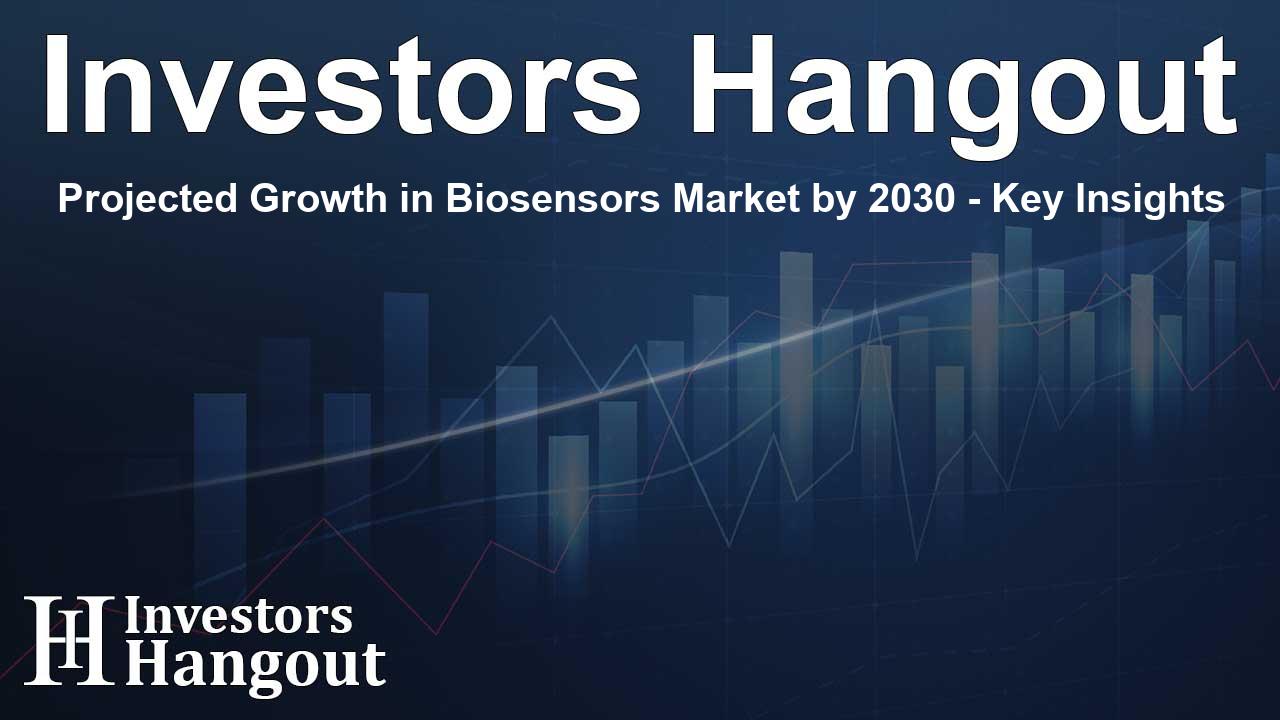Projected Growth in Biosensors Market by 2030 - Key Insights

Growing Future of the Biosensors Market
The biosensors market is on an impressive trajectory, with projections indicating substantial growth from USD 34.51 billion in 2025 to a staggering USD 54.37 billion by 2030. This represents a compound annual growth rate (CAGR) of 9.5%. This growth is driven by a variety of sectors, notably in healthcare, food safety, and environmental monitoring, showcasing the versatility and application of biosensor technology.
Understanding Biosensors
Biosensors are innovative devices that detect biological signals and convert them into measurable electrical outputs. They integrate a biological element, often derived from enzymes or antibodies, with a transducer that translates the biological response into an electronic signal. Since they can monitor various biological processes, biosensors hold immense potential for diverse applications including healthcare, food safety, and environmental monitoring.
Technological Advancements
One of the remarkable developments within the biosensors market is the rise of wearable biosensors. These devices allow for continuous health monitoring and are seeing a significant uptick in usage among patients, athletes, and individuals requiring ongoing health assessments. They can monitor vital signs, glucose levels, and other critical health parameters noninvasively, making healthcare more accessible, especially in remote or underserved areas. The technological evolution in this area has highlighted the urgent need for effective health monitoring solutions globally.
The Optical Revolution
In addition to wearable technology, optical biosensors are expected to dominate the market with one of the highest growth rates. These sensors analyze biomolecular interactions without the need for labels, providing real-time data essential for various applications like drug development and quality control in pharmaceuticals. Their efficiency, coupled with advancements in nanotechnology, improves their sensitivity and applicability in multiple fields.
Regional Insights and Market Trends
By 2030, North America is poised to be the leader in the biosensor market. Key factors contributing to this are the rising prevalence of chronic diseases among the population and innovations in point-of-care diagnostics. As the healthcare landscape evolves, biosensors are becoming crucial in disease management and early detection, particularly in chronic conditions where timely interventions can lead to better outcomes.
The adoption of biosensors in environmental monitoring is also expanding, allowing real-time assessment of environmental health indicators, which is particularly relevant given the increasing global concern for environmental sustainability.
Key Players and Competitive Landscape
Several key players in the biosensors sector are driving innovation and competitiveness. Companies like Abbott Laboratories and F. Hoffmann-La Roche Ltd are noteworthy for their advancements in biosensors. The competitive landscape includes various organizations specializing in medical devices, each contributing to the growing body of technology aimed at improving healthcare delivery and environmental protection.
Challenges and Opportunities
Despite promising growth, the biosensors market faces challenges, including regulatory hurdles and lengthy approval processes that can inhibit innovation and market entry. However, these challenges present opportunities, particularly for companies willing to invest in research and simplify compliance processes. The growing trend of integrating biosensors into wearables also serves as a vast opportunity for expansion.
Conclusion
The future of the biosensors market is incredibly promising, driven by technological innovations and increasing demand across various sectors. As health monitoring technology advances, the integration of biosensors will likely lead to healthier populations and safer environments, pushing the boundaries of what is possible in health management and ecological assessment.
Frequently Asked Questions
What factors are driving the growth of the biosensors market?
The growth is primarily driven by increasing demand for point-of-care diagnostics, wearable health monitoring devices, and environmental monitoring solutions.
What types of biosensors are seeing the highest growth?
Wearable biosensors and optical biosensors are currently experiencing the highest growth rates due to their innovative applications in healthcare monitoring and diagnostics.
Which regions are leading in the biosensors market?
North America is expected to lead the biosensors market, attributable to a rising patient population and advances in medical diagnostics technology.
What challenges does the biosensors market face?
The biosensors market faces challenges including regulatory barriers and long approval cycles, which can slow down product development and innovation.
How can companies capitalize on biosensor technology?
Companies can capitalize on biosensor technology by investing in R&D, streamlining compliance processes, and focusing on emerging trends such as wearable technology.
About The Author
Contact Addison Perry privately here. Or send an email with ATTN: Addison Perry as the subject to contact@investorshangout.com.
About Investors Hangout
Investors Hangout is a leading online stock forum for financial discussion and learning, offering a wide range of free tools and resources. It draws in traders of all levels, who exchange market knowledge, investigate trading tactics, and keep an eye on industry developments in real time. Featuring financial articles, stock message boards, quotes, charts, company profiles, and live news updates. Through cooperative learning and a wealth of informational resources, it helps users from novices creating their first portfolios to experts honing their techniques. Join Investors Hangout today: https://investorshangout.com/
The content of this article is based on factual, publicly available information and does not represent legal, financial, or investment advice. Investors Hangout does not offer financial advice, and the author is not a licensed financial advisor. Consult a qualified advisor before making any financial or investment decisions based on this article. This article should not be considered advice to purchase, sell, or hold any securities or other investments. If any of the material provided here is inaccurate, please contact us for corrections.
